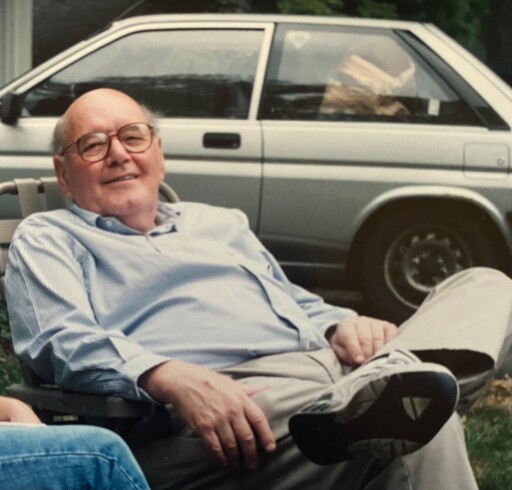

William Cleland Copeland
December 4, 1929 — August 27, 2023
William Cleland Copeland
Obituary For William Cleland Copeland
Mr Copeland (William Cleland Copeland) who was born in New Castle PA., died peacefully at home in Tucson, AZ on August 27 of 2023. He was 93 years old.
Bill Copeland grew up in New Castle, PA., Wheeling WV, and Dormont (Pittsburgh) PA. He graduated Muskingum College, New Concord, Ohio , in 1951, then did graduate work at The University of Pittsburgh (Psychology), Pittsburgh-Xenia Theological Seminary, and the University of Chicago Divinity School, where he was a Rockefeller Scholar. He served in the U.S. Army from 1955 to 1958 , in the Public Information Office of the 85th Infantry Regiment, 10th Infantry Division, in Bamberg, Germany (where he met and married his wife Lotte in 1957), in the U.S Army Military Intelligence School of Oberammergau, Germany, and then as Intelligence Translator (German language) in G-2, 7th Army Hqs., Stuttgart, Germany.
On his return to the U.S., he worked at the American Hospital Association in Chicago as Supervisor of theNational Census of Hospitals and the Hospital Guide Issue and Statistics of American Hospitals and in 1961, he entered the graduate program of biostatistics at the University of Minnesota, as an NIGMS Fellow. From 1963 to 1969 he worked for the Minneapolis-based Sister Kenny Rehabilitation Institute (later the American Rehabilitation Foundation) as a statistician and policy analyst. As his research results and publications became known he opened a Washington Research Group office in Washington D.C. for the Foundation in 1966. There he began to work with State and local governments on ways of accessing additional Federal revenue for those governments, using the revenue as an incentive to building community services for alcoholics, AFDC mothers who wanted to join the labor force and disabled persons (Who or who were at that time often institutionalized because there were no community services). As a lifelong democrat, he was a champion of progressive causes and was successful working across the aisle to implement programs. With the election of Richard Nixon in 1968, he was asked by the new Department of Health, Education and Welfare (HEW) Under-Secretary, Jack Veneman, to work on the HEW transition team. After a short time there, he worked as an outside liaison between the Department and State and local governments, which continued until 1972, when Regan-related executives took over the Department. The work he did in that period contributed much to the development of Title XX of the Social Security Act (now the Social Services Block-Grant)- the basis for beginning the building of community health and welfare services and the beginning of the end for many of the large institutions of that time. The building of that program, and some of Copeland’s work, is described in Martha Derthick’s 1976 National Book Award winning- Uncontrollable Spending For Social Services.
Mr. Copeland left the American Rehabilitation Foundation in 1969 and joined the Urban Institute as a senior fellow until 1970, when he left to start his own consulting firm, Copeland and Associate;, Inc., which continued as an active force in health and human services fields until the early 2000’s.
From 1976 to 1983, with the generous help of Professors Nancy Eustis and John Brandl, he taught in the University of Minnesota Graduate School’s Hubert H. Humphrey Institute for Public Affairs. While there, he developed a federal financing approach to deinstitutionalization of the aged and disabled (with Iver A. Iverson) which, in working with activists in the field, such as Tom Gilhool of Philadelphia Public Interest Law Firm (Pilcop) and Linda Glenn (who developed the first system for providing housing and services for persons leaving institutions in Nebraska- ENCOR), OMB staff, and Congressional Offices (especially that of Representative Waxman of California)
That approach became the Home and Community Based Services Act of 1981. With the passage of the ACT, the Federal Department of Health & Human Services asked Copeland to work with States and teach them how to define state budgets for deinstitutionalization in such a way that the 150,000+ beds in state institutions could be closed. Then beginning a 20-year consulting partnership with Linda Glenn, the firm participated in planning, in detail, with five states, for the complete closure of all institutions. The results of the Act have been so popular that it expanded in scope and size many times by bi-partisan majorities, so that large state institutions have declined from 150,000 census in 1980 to about 30,000 today, and about 400,000 persons are now receiving community services in their own homes or in small- apartment programs.
After the completion of a very large project in Georgia, which returned more than $3 billion in new Federal funds to the state- much of which was spent in reforming children’s services and extending the Medicaid program, most of Mr. Copeland’s partners and subcontractors retired- and so did Copeland. He and Lotte, his wife since 1957, after having lived for more than 30 years in Minneapolis, moved to Tucson, AZ in 1997.
Copeland had a genuine curiosity and deep interest in people. He would always listen intently to truly hear and understand what they were saying. When Bill talked, people listened because he offered meaningful insights. His work was his passion, and he was always game for a new venture, right to his last day. When Bill got involved, things started to happen. Bill maintained many connections within the halls of power but chose to surround himself with all kinds of people and never denied anyone a helping hand in any way within his power.
It should be noted that Copeland enjoyed working partnerships with a number of very capable people who shared the same social goals: Iver. A. Iverson, Eugene Lourey and Rocco D’Amico, Linda Glenn, Norman Zimlich and Carl Valentine, Tony Lourey, Richard Mann, Dr. Barry Griffin, Michael DeVegter, David Kleinberg, Mike Davis and the late Victor Kugajevski. He became a lifetime friend and mentor of those he worked with. He never lost contact with each one. They have repeatedly let the family know how important he was in their lives.
Copeland also enjoyed the long-time friendship of college, grad school and Army friends: his college roommate and lifelong friend, the late Professor Bruce Brackenridge, his wife Mary Ann Rossi and children, Professor David Marshall and Thompson Bradley, the late Dan Potter, Dr. Robert Schneck, David Doth, Sister-in-law Elfi Wehner and her partner, Guenter Herr, in Bamberg, Germany.
He was the youngest and last surviving child of The Reverend Doctor Samuel Bruce Copeland and Margaret Wilson Copeland. His siblings Jean Copeland Basnett, John Wilson Copeland and Samuel Bruce Copeland, Jr., died earlier. He is survived by his wife, Lotte B. Copeland, children Katherine Copeland Anderson (Andre) and David Bruce Copeland (Amanda), and his eight grandchildren.
Most of all, Bill was a loving husband and supporting father who passed on a legacy that will continue to drive his children and grandchildren to great heights.
A celebration of William Copeland’s life will take place at a later date.
Guestbook
Visits: 16
This site is protected by reCAPTCHA and the
Google Privacy Policy and Terms of Service apply.
Service map data © OpenStreetMap contributors





